What we know
Mercury is the smallest, innermost, and least explored of the planets in the inner Solar System.
The little world remained completely mysterious until the 1970s, and to date only two missions have visited and observed Mercury up close: NASA's Mariner 10 probe, which launched in 1973, and NASA's MESSENGER (MErcury Surface, Space ENvironment, GEochemistry, and Ranging) mission, which launched over three decades later in 2004.
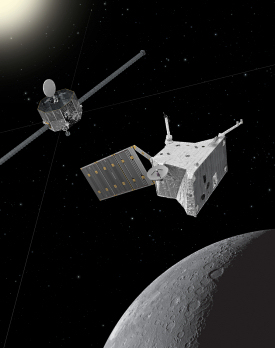 |
| BepiColombo at Mercury. Credit: Spacecraft: ESA/ATG medialab; Mercury: NASA/Johns Hopkins University Applied Physics Laboratory/Carnegie Institution of Washington |
BepiColombo, a joint endeavour between the European Space Agency (ESA) and the Japan Aerospace Exploration Agency (JAXA), was successfully launched on 20 October 2018, and will bring the number of Mercury missions to three when it arrives at the planet in late 2025.
A challenging destination
The surprising scarcity of spacecraft bound for Mercury is not because the planet is uninteresting, but because the innermost parts of the Solar System are a challenging region for exploration.
Mercury is incredibly close to the Sun–on average just under 60 million km compared to the Earth's nearly 150 million km–and as a result its environment is harsh and unfamiliar to our equipment. This is especially true when it comes to temperature.
In its hottest regions–at the equator during the day–Mercury's surface temperature can hit highs of over 400 degrees Celsius, while its coolest parts–the poles and at night–can dip to a bone-chilling -170 degrees Celsius. Any technology we send to the Sun-seeking planet must be able to endure long-term temperatures that are not only incredibly intense, but also highly changeable.
Additionally, Mercury's orbit is difficult for our probes to reach. Even when the Earth-Mercury distance is at a minimum, a great deal of energy is needed to brake any spacecraft into a suitable orbit such that it could intersect with Mercury's path and encounter the planet. The velocity change (referred to as the delta_v) that is needed to reach Mercury is about 18.5 km/s. To reach the dwarf planet Pluto, a delta_v of about 17km/s is required, and the Rosetta mission to comet 67P/Churyumov-Gerasimenko needed about 5 km/s all together.
| BepiColombo's journey to Mercury. Click here for details and large versions of the video. Credit: ESA |
Views of Mercury
Prior to our robotic exploration of Mercury, astronomers observed the planet as best they could given its small size and proximity to the Sun.
They sketched rough maps of the dark patches marring its surface, and conducted Earth-based experiments to hunt for signs of an atmosphere. They found no signs of one, forming the picture of Mercury that is still largely prevalent today: that of an ancient, dead, irradiated world, scorched by the fierce radiation streaming outwards from the Sun, with no water, ice, or weather to speak of.
In 1973, NASA decided to discover whether or not this picture was accurate, and launched the first mission bound for Mercury: Mariner 10.
Mariner 10
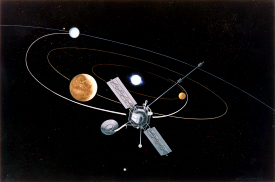 |
| Mariner 10. Credit: NASA |
Initially known as the Mariner-Venus-Mercury mission, Mariner 10 lifted off from Cape Canaveral, Florida, on 3 November 1973, and began its journey to Mercury. As its name suggests it was part of the agency's Mariner programme, which sent ten spacecraft to explore Venus (Mariners 1, 2, 5, 10), Mars (Mariners 3, 4, 6, 7, 8, 9), and Mercury (Mariner 10) through the 1960s and '70s with varying degrees of success.
Mariner 10 was not only the first mission to visit Mercury, but also the first to use the gravity of one planet to reach another–a manoeuvre known as a gravity assist or gravitational slingshot.
The spacecraft swung past Venus at a distance of 5768 km on 5 February 1974, observing the planet as it did so and simultaneously readjusting its speed and orbital trajectory to put it on course for Mercury. This technique was proposed by the Italian scientist Giuseppe "Bepi" Colombo (1920-1984), after whom the ESA/JAXA BepiColombo mission is named.
On 29 March 1974 the spacecraft skimmed some 703 km from Mercury's surface, and continued onwards to loop around the Sun. It performed three fly-bys of Mercury in total (29 March and 21 September 1974 and 16 March 1975).
The earlier gravity assist at Venus was crucial; Mariner 10 used Venus to realign its perihelion (closest approach to the Sun) to be at or around Mercury's orbit, enabling the probe to encounter the small planet more than once and thus perform multiple fly-bys using very little fuel.
There was, however, one drawback to this method: each time Mariner 10 approached Mercury it would see the surface under the same lighting conditions, making it impossible to gain a complete view of the planet and its characteristics.
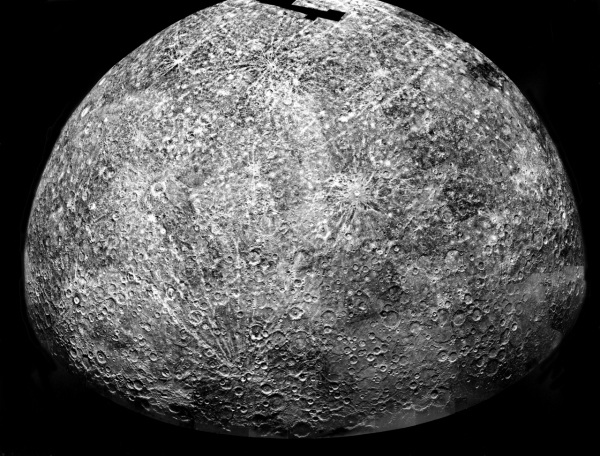 |
| Mariner 10's Mercury. Credit: NASA |
Mariner 10…
- …imaged heavily cratered terrain and surface features.
Mariner 10 sent back images of an intensely cratered surface. Early photographs showed Mercury's southern hemisphere as pitted, rough, speckled with scars from previous impacts, and reminiscent of the Moon's pockmarked ancient highlands. Images showed various types of terrain (intercrater plains, smooth plains, patches of heavy cratering), a giant impact basin named Caloris, and steep cliffs some hundreds of kilometres long (possibly formed by the planet's crust shrinking as it cooled).
- …detected a magnetic field.
As Mercury is so small, scientists expected the planet's iron core to have cooled down and solidified billions of years ago, abruptly halting the churning motions of any core dynamo that would drive a magnetic field. However, Mariner 10 data (plasma and particle) detected a substantial magnetic dipole similar to that of Earth.
- …mapped approximately 45% of Mercury's surface.
Mariner 10 imaged approximately 45% of the planet's surface, sending back over 2300 black-and-white images of Mercury (many with a moderate resolution of 3 to 20 km per pixel, and some with a higher resolution of 140 m per pixel).
- …characterised Mercury's atmosphere and exosphere.
Mariner 10's third fly-by gathered data on Mercury's potential magnetosphere (the area of space over which the planet's magnetic field dominates), and explored how this interacts with the wind of particles emanating from the Sun (the solar wind). While the planet does not have an atmosphere, it was found to host a very thin atmospheric layer known as an exosphere – a tenuous, unstable and short-lived band of particles held loosely in place by Mercury's gravity. The planet's surface pressure was measured to be about one trillionth (1/1,000,000,000,000) of the air pressure at sea level on Earth.
Mariner 10 ran out of fuel and shut down on 24 March 1975. The data it gathered during its relatively brief fly-bys formed the entirety of our knowledge about the planet for over three decades, until NASA decided to send a second mission to Mercury: MESSENGER.
MESSENGER (MErcury Surface, Space ENvironment, GEochemistry, and Ranging)
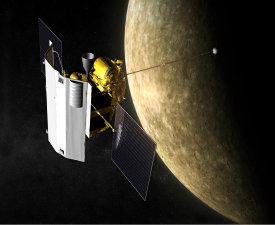 |
| MESSENGER. Credit: NASA/Johns Hopkins University Applied Physics Laboratory/Carnegie Institution of Washington |
Despite its success Mariner 10 imaged less than half of Mercury's surface, and the little planet still remained largely unknown – especially when compared to our knowledge of our other planetary neighbours. MESSENGER aimed to remedy this. The spacecraft launched on 3 August 2004 and began its nearly eight-billion-km journey to the inner Solar System.
As its predecessor had done, MESSENGER used multiple gravity assists to reach Mercury. It swung around the Sun 15 times, also slingshotting past Earth, Venus, and Mercury itself. Overall, MESSENGER performed three separate fly-bys of Mercury (January 2008, October 2008, September 2009) before entering orbit around the planet on 18 March 2011.
Its orbit was highly elliptical and took it near the planet’s poles. During the nominal mission, until March 2012, the probe orbited Mercury twice every 24 hours, with a closest approach (periapsis) of 200 km and furthest (apoapsis) of over 15 000 km. During the extended mission, the orbital period and closest distance changed. MESSENGER orbited the planet until it ran out of fuel and deliberately crashed to the surface on 30 April 2015.
MESSENGER…
- …mapped almost the entire planet.
MESSENGER mapped almost all of Mercury's surface during its fly-bys, using its multispectral imaging system and laser altimeter to image the planet in stereo and identify different landforms and topographic variations. MESSENGER showed that, unlike the densely cratered terrain spied by Mariner 10, large parts of Mercury's surface had been resurfaced by volcanism to form smoother plains (most prominently a large region in Mercury's northern hemisphere). The Caloris basin was also found to contain volcanic material similar to the basalt flows seen on the Moon.
- …discovered unique surface features.
MESSENGER discovered shallow, irregular, reflective depressions called 'hollows' within craters and on the planet's plains. These features appear to be unique to Mercury, and are thought to form as material at, or just beneath Mercury's surface sublimates (changing from solid to gas).
- …explored the composition of Mercury's rock.
MESSENGER's various spectrometers determined the elemental and mineral composition of the rocks on Mercury's surface. Despite the planet's high density and presumed iron core, Mercury appeared to have low amounts of iron on its surface, and high abundances of volatile elements (sulphur, sodium, chlorine).
- …saw signs of water ice within craters.
The mission found strong evidence that water ice has survived in Mercury's polar regions.
- …measured Mercury's magnetic and gravitational fields, and determined the thickness of its crust.
MESSENGER helped to determine the thickness and structure of Mercury's crust, and mapped the planet's gravitational field. Mercury's internal magnetic field was found to be 100 times weaker than that of Earth, thus providing very little protection from the solar wind.
 |
| MESSENGER's global coverage of Mercury. Credit: NASA/Johns Hopkins University Applied Physics Laboratory/Carnegie Institution of Washington |
BepiColombo
There is still much left to discover about Mercury. BepiColombo is a dual-spacecraft mission equipped with numerous state-of-the-art instruments and sensors to explore Mercury–and, by extension, the history of our entire Solar System–in greater depth than ever before.
BepiColombo, with its two spacecraft orbiting Mercury at the same time and with comprehensive and state-of-the-art payloads, is perfectly suited to follow up on MESSENGER. So far each mission to Mercury revealed some new surprises and BepiColombo is expected to do the same.
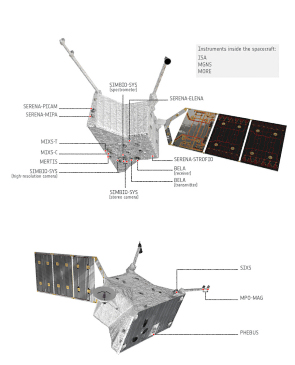 |
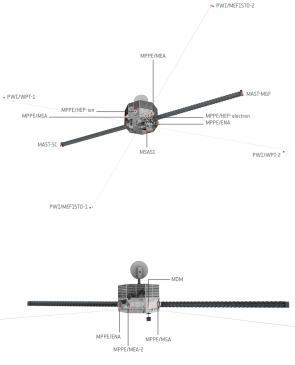 |
| BepiColombo MPO's science instruments. Credit: ESA/ATG medialab | BepiColombo Mio's science instruments. Credit: ESA/ATG medialab |
